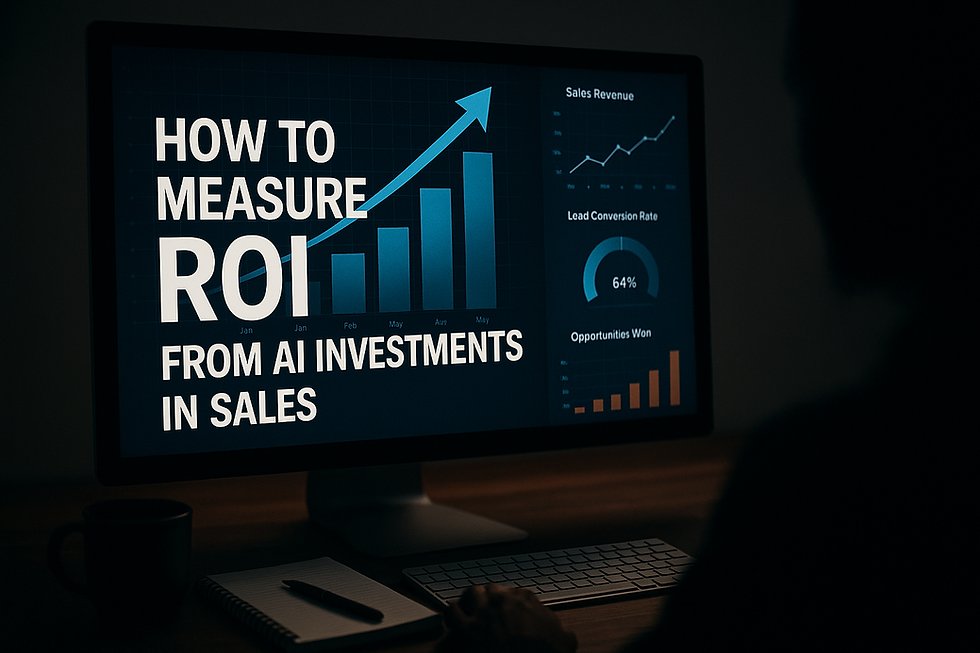What Is Machine Learning in Sales? A Beginner’s Guide for Business Owners
- Muiz As-Siddeeqi

- 4 days ago
- 6 min read

This Isn’t Another Tech Buzzword Guide. This Is Survival for Business Owners.
We’re going to be brutally honest from the start — if you’re a business owner in 2025 and you still haven’t understood how machine learning (ML) can transform your sales, you’re already falling behind.
Not because it’s trendy.
But because your competitors already know what you don’t.
And what they know is this: ML isn’t about robots replacing your team. It’s about giving your sales reps superpowers they never had before.
If you’ve been hearing the term “machine learning in sales” and brushing it off as Silicon Valley hype, this is your wake-up call — written in the simplest English, with zero technical fluff, and backed by real stats, real businesses, and real use cases.
This blog isn’t just any guide. It’s a ground-zero, no-nonsense, fully documented, beginner’s map — crafted specifically as the ultimate guide to machine learning in sales for beginners. We’ve designed it for business owners like you who want to compete, thrive, and win in today’s AI-first world.
Let’s begin.
Bonus: Machine Learning in Sales: The Ultimate Guide to Transforming Revenue with Real-Time Intelligence
But First… What Is Machine Learning, Really?
Let’s strip away the academic fog and define machine learning in the simplest, most business-relevant way possible.
Machine learning is a type of software that learns patterns from data and makes predictions or decisions — without being explicitly programmed to do so.
It’s not magic. It’s math. But the results can feel magical when applied right.
Think of it like this:
You feed your past sales data to a machine.
The machine figures out patterns (like which types of leads are more likely to convert, or what time of day people buy).
Then it uses those patterns to help you make future sales decisions automatically.
That’s it. That’s the engine behind some of the most profitable and fastest-growing sales organizations on the planet.
Why Every Business Owner Must Care — Not Just Tech Giants
You may be thinking:
“I run a mid-sized business, not Amazon. Why should I care?”
Because even small businesses are now getting crushed or catapulted by machine learning.
A 2024 study by McKinsey & Company found that companies using machine learning in sales achieved:
15-25% increase in lead conversion rates
20-30% improvement in sales forecasting accuracy
Up to 50% reduction in customer churn(Source: McKinsey, “The State of AI in 2024” Report)
In Pakistan, a 2023 report by KTrade showed that retail businesses using predictive ML tools increased their sales by up to 22% quarter-over-quarter without expanding sales teams.
Let that sink in: more sales, less effort, same team — just by making their software smarter.
The Only Beginner-Friendly Definition of “Machine Learning in Sales” You’ll Ever Need
Here’s our definition — real, simple, and sales-first:
Machine learning in sales means using intelligent software that learns from your past sales data and helps you: Predict which leads will close. Automate repetitive follow-ups. Score prospects accurately. Personalize outreach for better engagement. Forecast revenue more precisely.
No fluff. Just impact.
Real Businesses Using ML in Sales — With Results to Prove It
Here are real, documented case studies — not fictional, not hypothetical:
1. HubSpot
HubSpot, a CRM and marketing platform, uses machine learning to score leads automatically. In 2023, they reported that their ML-powered lead scoring reduced sales rep qualification time by 40% — leading to faster conversions and a more efficient sales cycle.
(Source: HubSpot Product Update Blog, March 2023)
2. Dell Technologies
Dell used ML models to forecast quarterly sales more accurately. In a 2022 report, they showed that AI-driven forecasting improved accuracy from 75% to 92%, helping reduce overproduction and optimizing inventory.(Source: Dell AI and Sales Transformation Whitepaper, 2022)
3. Lenskart (India)
The online eyewear retailer used ML to predict customer preferences based on browsing behavior. Their personalized product recommendations (driven by ML) boosted conversion rates by 32%.(Source: Lenskart & Google AI Retail Webinar, 2023)
7 Things Machine Learning Can Do for Your Sales — Starting Today
Here’s exactly how ML is reshaping sales for business owners worldwide:
1. Predict Who Will Buy — Before They Even Click “Buy”
ML models analyze customer behavior and tell your reps which leads are hot and which are cold — no guessing.
Real-world impact: According to Salesforce’s 2024 report, companies using predictive lead scoring saw 21% higher win rates.
2. Score Leads Automatically
No more manual spreadsheets. ML can rank leads based on their likelihood to convert — so your team focuses only on the most promising ones.
Real-world impact: Adobe reported that their predictive lead scoring cut down manual lead qualification by 60%.(Source: Adobe Digital Experience Insights, 2023)
3. Forecast Sales with Near-Perfect Precision
Instead of vague gut feelings, ML forecasts based on trends, seasonality, and behavior patterns from historical data.
Real-world impact: According to Gartner (2023), companies that use ML for sales forecasting are 1.5x more likely to hit quarterly targets.
4. Automate Repetitive Follow-Ups
ML systems can send personalized emails at the right time to the right people — nurturing leads while your reps focus on closing.
5. Optimize Discounts and Pricing Dynamically
ML algorithms can suggest discounts for leads that are price-sensitive — maximizing revenue and protecting profit margins.
6. Identify Customers Likely to Churn
It can spot signs of churn — like reduced logins or fewer support tickets — before it happens, so you can re-engage at the right time.
7. Personalize Outreach at Scale
ML helps tailor your sales pitch based on a lead’s industry, behavior, and preferences — at scale.
Real-world impact: Netflix’s personalization engine (built on ML) saves them $1 billion annually by reducing churn.(Source: Netflix Tech Blog, 2023)
Don’t Worry, You Don’t Need to Hire Data Scientists Right Away
Here’s the great news: you don’t have to build ML from scratch.
You can start using ML-powered tools that are plug-and-play and already built for business owners like you.
Top Tools That Bring ML into Your Sales Without Coding:
HubSpot (ML-based lead scoring)
Salesforce Einstein (predictive sales analytics)
Zoho CRM (AI sales assistant “Zia”)
Gong.io (analyzes sales calls using ML)
Clari (forecasting and pipeline analysis)
Conversica (AI sales assistant for automated follow-up)
These tools bring machine learning to your sales team without needing to write a single line of code.
The Beginner’s Checklist — How to Actually Start Using ML in Your Sales
Here’s a step-by-step roadmap designed just for business owners who don’t have tech teams:
Step 1: Audit Your Sales Data
Gather historical CRM data: leads, conversions, customer behaviors.
Clean it — remove duplicates, fix errors.
Tip: Even basic data like lead source, deal size, and stage history is enough to start.
Step 2: Choose an ML-Enabled CRM or Tool
Pick a tool like Salesforce, Zoho, or HubSpot that already integrates machine learning.
Step 3: Start with One Use Case
Don’t do everything at once. Start with:
Lead scoring OR
Sales forecasting OR
Churn prediction
Test it. Learn. Scale later.
Step 4: Monitor, Adjust, and Improve
Machine learning models learn continuously. Give feedback. Adjust thresholds. And regularly update the data feeding the system.
Important: Machine Learning Isn’t “Set and Forget”
Many business owners make this mistake. ML tools need clean data and ongoing validation.
Real Insight: A 2023 report by MIT Sloan Management Review found that 43% of businesses using AI for sales had underperforming models — mainly because they failed to retrain them regularly.
Your model is only as good as the data and attention you give it.
Frequently Asked Beginner Questions (And Real Answers)
Is machine learning expensive?
Not anymore. Tools like Zoho CRM or Pipedrive offer ML features even in low-tier plans.
Will my team need technical training?
Not really. Most ML-powered sales tools are visual, drag-and-drop, or have simple dashboards.
What if I don’t have a lot of data?
Start anyway. Even 3–6 months of sales data is enough for basic predictions. ML tools today are designed to work with smaller data sets too.
Final Thoughts: This Isn’t Optional Anymore
Machine learning in sales isn’t the future. It’s the present — already adopted by thousands of companies across the globe.
This blog wasn’t about hype. It was about giving you real, documented proof that:
Machine learning works in sales.
It’s accessible.
It’s becoming essential.
Whether you’re running a team of 5 or 500 — the earlier you adopt it, the faster you grow, and the further you pull ahead.
So let this not just be the blog you read.
Let this be the blog that changed how your sales team works forever.






Comentários